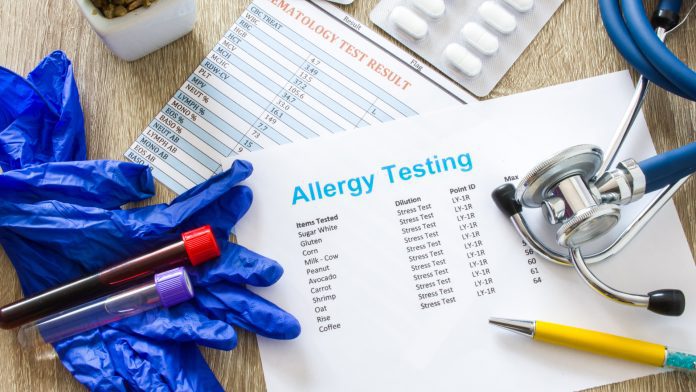
Researchers have developed a novel allergy test that simplifies the diagnosis of allergies and can reliably predict the success of therapy.
Around one-third of the world’s population suffers from one or more allergies, with the trend increasing yearly. The most widespread form of allergy is the type I allergy, known as immediate-type allergy. This includes hay fever, allergic asthma, food allergies and many more. Allergic symptoms can include redness and swelling of skin, itching or shortness of breath. There is a range of allergy tests available, with the most common one being skin prick testing. However, this allergy test can be unpleasant, time-consuming and associated with a certain risk of triggering an allergic reaction.
A research group led by Alexander Eggel from the Department for BioMedical Research (DBMR) at the University of Bern and the Department of Rheumatology and Immunology, Inselspital, Bern University Hospital, together with Thomas Kaufmann from the Institute of Pharmacology at the University of Bern, has now developed an allergy test that simplifies diagnosis and predicts the success of immunotherapy.
The study was published in the Journal of Allergy and Clinical Immunology.
Innovative novel allergy test
Type I allergy typically occurs when the body produces immunoglobulin E (IgE) class antibodies in response to allergens. The IgE antibodies are bound by IgE receptors on the surface of specialised immune cells in the body called mast cells. Contact with the same allergens then leads to activation of the mast cells and therefore to the release of inflammatory mediators such as histamines or leukotrienes, which are responsible for the allergic symptoms.
The researchers developed their novel allergy test by creating a new in vitro cell culture which generates almost any desired number of mature mast cells within a few days. These mast cells contain Ig3 receptors on their surface and behave similarly to mast cells in the human body when they are exposed to IgE and allergens. In the allergy test, these mast cells come in contact with blood serum from allergic individuals, binding the IgE antibodies from the serum to the cells then stimulated with the allergens to be tested. At this point, the activation of the cells can be quantified very easily and quickly using so-called flow cytometry.
“We were surprised and delighted to see that our mast cells could be activated at almost 100 per cent. To our knowledge, there are no comparable cell lines that can be activated so well,” explained Alexander Eggel. “Another important advantage is that the test works with serum, which is very stable and can be stored frozen for a long time, which also allows retrospective tests and studies. In contrast, other comparable tests use whole blood, which cannot be stored and must be processed within hours.”
The researchers also developed the allergy test to have the ability to measure up to 36 conditions in a single test tube. “A trained person can already perform about 200 tests per day using this procedure, and the process will be further optimised,” clarified DBMR’s Noemi Zbären, lead author of the study.
New testing opportunities
In addition to the allergy test, the researchers aspire for their new test to be applied widely. “We are confident that with our test, we will be able to measure within a few months after the start of an immunotherapy whether the therapy is effective and to what extent,” said Thomas Kaufmann. “This would be an important aid in the decision-making process for the allergologist treating the patient, whether it makes sense to continue the therapy or not.”
The researchers illustrated that their allergy test has the potential for monitoring therapeutic success and the duration of action for new allergy medications in clinical trials, along with determining possible allergic reactions and for quality control of food products.







